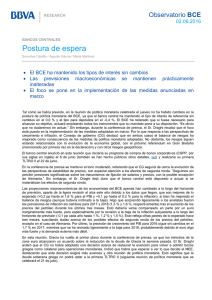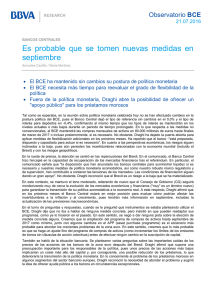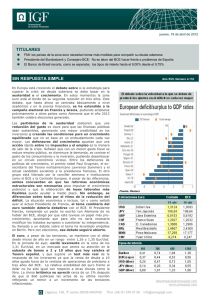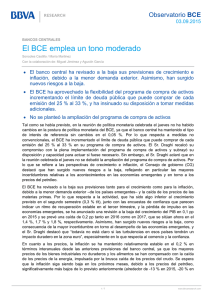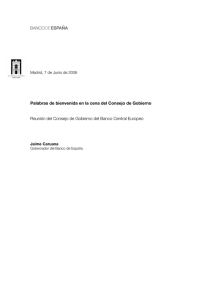CENTRAL BANKS - BBVA Research
Anuncio
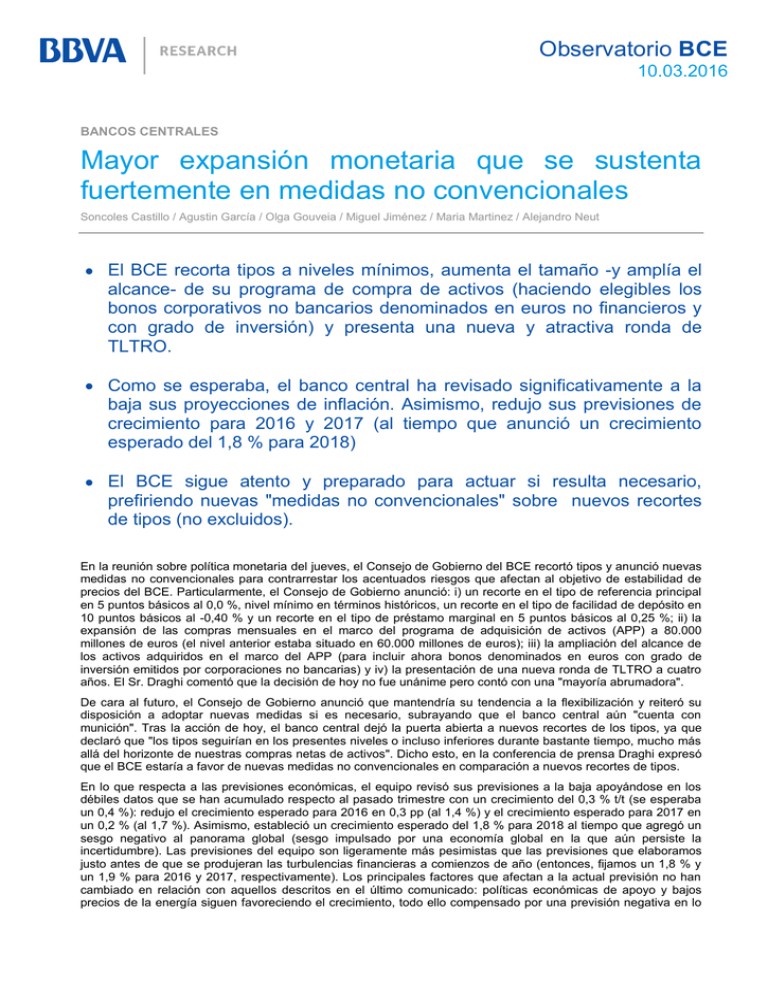
Observatorio BCE 10.03.2016 BANCOS CENTRALES Mayor expansión monetaria que se sustenta fuertemente en medidas no convencionales Soncoles Castillo / Agustin García / Olga Gouveia / Miguel Jiménez / Maria Martinez / Alejandro Neut El BCE recorta tipos a niveles mínimos, aumenta el tamaño -y amplía el alcance- de su programa de compra de activos (haciendo elegibles los bonos corporativos no bancarios denominados en euros no financieros y con grado de inversión) y presenta una nueva y atractiva ronda de TLTRO. Como se esperaba, el banco central ha revisado significativamente a la baja sus proyecciones de inflación. Asimismo, redujo sus previsiones de crecimiento para 2016 y 2017 (al tiempo que anunció un crecimiento esperado del 1,8 % para 2018) El BCE sigue atento y preparado para actuar si resulta necesario, prefiriendo nuevas "medidas no convencionales" sobre nuevos recortes de tipos (no excluidos). En la reunión sobre política monetaria del jueves, el Consejo de Gobierno del BCE recortó tipos y anunció nuevas medidas no convencionales para contrarrestar los acentuados riesgos que afectan al objetivo de estabilidad de precios del BCE. Particularmente, el Consejo de Gobierno anunció: i) un recorte en el tipo de referencia principal en 5 puntos básicos al 0,0 %, nivel mínimo en términos históricos, un recorte en el tipo de facilidad de depósito en 10 puntos básicos al -0,40 % y un recorte en el tipo de préstamo marginal en 5 puntos básicos al 0,25 %; ii) la expansión de las compras mensuales en el marco del programa de adquisición de activos (APP) a 80.000 millones de euros (el nivel anterior estaba situado en 60.000 millones de euros); iii) la ampliación del alcance de los activos adquiridos en el marco del APP (para incluir ahora bonos denominados en euros con grado de inversión emitidos por corporaciones no bancarias) y iv) la presentación de una nueva ronda de TLTRO a cuatro años. El Sr. Draghi comentó que la decisión de hoy no fue unánime pero contó con una "mayoría abrumadora". De cara al futuro, el Consejo de Gobierno anunció que mantendría su tendencia a la flexibilización y reiteró su disposición a adoptar nuevas medidas si es necesario, subrayando que el banco central aún "cuenta con munición". Tras la acción de hoy, el banco central dejó la puerta abierta a nuevos recortes de los tipos, ya que declaró que "los tipos seguirían en los presentes niveles o incluso inferiores durante bastante tiempo, mucho más allá del horizonte de nuestras compras netas de activos". Dicho esto, en la conferencia de prensa Draghi expresó que el BCE estaría a favor de nuevas medidas no convencionales en comparación a nuevos recortes de tipos. En lo que respecta a las previsiones económicas, el equipo revisó sus previsiones a la baja apoyándose en los débiles datos que se han acumulado respecto al pasado trimestre con un crecimiento del 0,3 % t/t (se esperaba un 0,4 %): redujo el crecimiento esperado para 2016 en 0,3 pp (al 1,4 %) y el crecimiento esperado para 2017 en un 0,2 % (al 1,7 %). Asimismo, estableció un crecimiento esperado del 1,8 % para 2018 al tiempo que agregó un sesgo negativo al panorama global (sesgo impulsado por una economía global en la que aún persiste la incertidumbre). Las previsiones del equipo son ligeramente más pesimistas que las previsiones que elaboramos justo antes de que se produjeran las turbulencias financieras a comienzos de año (entonces, fijamos un 1,8 % y un 1,9 % para 2016 y 2017, respectivamente). Los principales factores que afectan a la actual previsión no han cambiado en relación con aquellos descritos en el último comunicado: políticas económicas de apoyo y bajos precios de la energía siguen favoreciendo el crecimiento, todo ello compensado por una previsión negativa en lo Observatorio BCE 10.03.2016 que respecta a la actividad en el exterior y los mercados financieros, un elevado nivel de deuda y reformas estructurales a ritmo lento. Los riesgos continúan estando marcados por un sesgo bajista. Por lo que atañe a la inflación, el BCE señaló que durante los próximos meses continuará estando situada en terreno negativo y que hacia el final del año debería repuntar. Las revisiones a la baja de las proyecciones sobre inflación están en línea con lo que esperábamos dada la perspectiva del precio del petróleo y las recientes sorpresas negativas: del 1 % al 0,1 % en 2016 y del 1,6 % al 1,3 % en 2017, mientras que para 2018 esperan un 1,6 % (en este caso, nuestra previsión era ligeramente más optimista). La inflación subyacente se revisa la baja en 2 y 3 puntos decimales para 2016 y 2017, al 1,1 % y al 1,3 %, respectivamente, contemplándose un valor proyectado para 2018 de 1,6 %. El comunicado no hace referencia a riesgos inflacionistas en ninguna dirección, pero señala que permanecerán alerta en lo que respecta a los efectos de segunda ronda (algo que el señor Draghi mencionó previamente en varias ocasiones.) En la rueda de prensa, se hizo hincapié en las numerosas medidas anunciadas y el señor Draghi destacó que el BCE aún cuenta con munición, incluyendo recortes de tipos adicionales e incluso con nuevas "medidas no convencionales" si resulta necesario. Recortes de tipos adicionales. El Consejo de Gobierno recortó el tipo de referencia principal en otros 5 pb hasta el 0,0 %, un mínimo histórico, la facilidad de depósito en 10 pb, hasta -0,10 % y el tipo de interés para préstamos marginal en 5 pb, hasta 0,25 %, manteniendo de esta manera una banda de fluctuación asimétrica para los tipos de interés. Al ser preguntado sobre por qué razón el BCE no había introducido una tasa de depósito por tramos (una de las posibles medidas que los mercados esperaban como una forma de suavizar el impacto de los tipos negativos sobre el sector bancario), el Sr. Draghi respondió que el Consejo de Gobierno no deseaba indicar que los recortes de tipos seguirían siendo la herramienta preferente (asimismo, destacó su complejidad técnica). Aumento adicional de las compras mensuales en el marco del programa de compra de activos. El Consejo de Gobierno decidió incrementar la cantidad destinada a compras mensuales pasando de 60.000 millones de euros a 80.000 millones de euros. El banco central mantendrá el programa hasta finales de marzo de 2017, siempre que la inflación se ajuste efectivamente a medio plazo permaneciendo por debajo del 2 % (pero cerca de dicha cifra). Ampliación del alcance de los activos elegibles para el programa de compra de activos. El banco central decidió incluir en la lista de activos elegibles para efectuar compras de modo regular los “bonos denominados en euros con grado de inversión emitidos por corporaciones no bancarias establecidas en la zona euro”. La inclusión de bonos corporativos no fue anticipada por los mercados y abre la puerta a la adquisición de un nuevo conjunto de activos denominados en euros. Aumento de los límites de emisión y emisor en el marco del programa de compra de activos. Se elevó el límite aplicado a la adquisición de valores emitidos por organizaciones internacionales y bancos de desarrollo multilaterales elegibles, pasando del 33 % al 50 %. Una nueva ronda de TLTRO. Comenzando en junio de 2016, se lanzará una nueva serie de cuatro operaciones de refinanciación a largo plazo (TLTRO II), cada una de las cuales tendrá un vencimiento a cuatro años. Las noticias son bien acogidas por los bancos de la eurozona que sufren la presión de tipos de depósito negativos, ya que estos cuatro TLTRO II no incluyen prepagos obligatorios, no implican el condicionamiento de que los bancos aumenten sus préstamos a la economía y se les aplica un tipo de interés máximo del 0 % (si el tipo para las MRO no aumenta hasta marzo de 2017) y un tipo mínimo del 0,4 % (o bien el tipo que se aplique a la facilidad de depósito en la fecha de la subasta). La cantidad de préstamos que pueden solicitarse es considerable: el 30% de los préstamos elegibles con fecha 31 de enero de 2016, es decir, ~1,7 tr € menos los 200.000 millones de euros prestados en los TLTRO de 2014. De esta manera, el coste de estos fondos resulta muy favorable (potencialmente negativo) y la posibilidad de refinanciar los actuales TLTRO mediante el nuevo TLTRO II -junto con el vencimiento a cuatro años- elimina cualquier preocupación acerca de la financiación destinada a los bancos europeos. Las medidas que se han adoptado se producen casi un año después del anuncio del BCE de compra de bonos gubernamentales de la eurozona (9 de marzo de 2015). Mediante los significativos anuncios que se han producido en esta reunión, el BCE subrayó que existe espacio para adoptar nuevas medidas, descartando la visión de que ya se ha hecho todo lo que se podía hacer en términos de política de flexibilización, recalcando que, en caso de necesidad, el Consejo de Gobierno preferiría aplicar medidas no convencionales por encima de recortes adicionales de tipos. Dicho esto, a pesar de los anuncios realizados (que han sido bien acogidos), hay que tener en cuenta que: el BCE tiene cada vez menos margen para maniobrar al tiempo que, como afirmó Draghi, la efectividad de las medidas monetarias adicionales disminuye en la medida en que no estén acompañadas de estímulos fiscales coordinados. Observatorio BCE 10.03.2016 DESTACADO: sobre el formato del comunicado del BCE: El aparente formato “control de cambios” que se emplea a continuación tiene por objeto facilitar el seguimiento de cambios del comunicado respecto a la anterior reunión del BCE. En negro aparece la parte del comunicado que se mantiene sin cambios. En azul y subrayado las novedades de la última reunión y en rojo y tachado, el texto que no aparece en el nuevo comunicado Mario Draghi, President of the ECB, Vítor Constâncio, Vice-President of the ECB, Frankfurt am Main, 21 January10 March 2016 Ladies and gentlemen, first of all let me wish you a Happy New Year. Thethe Vice-President and I are very pleased to welcome you to our press conference. We will now report on the outcome of today’s meeting of the Governing Council, which was also attended by the Commission Vice-President, Mr Dombrovskis. Based on our regular economic and monetary analyses, and after we have conducted a thorough review of the recalibration of monetary policy stance, in which we also took into account the new macroeconomic projections by our monetary policy measures last month, westaff extending into the year 2018. As a result, the Governing Council has decided on a set of measures in the pursuit of its price stability objective. This comprehensive package will exploit the synergies between the different instruments and has been calibrated to keepfurther ease financing conditions, stimulate new credit provision and thereby reinforce the momentum of the euro area’s economic recovery and accelerate the return of inflation to levels below, but close to, 2%. First, as regards the key ECB interest rates unchanged and we expect them, we decided to lower the interest rate on the main refinancing operations of the Eurosystem by 5 basis points to 0.00% and the rate on the marginal lending facility by 5 basis points to 0.25%. The rate on the deposit facility was lowered by 10 basis points to -0.40%. Second, we decided to expand the monthly purchases under our asset purchase programme from €60 billion at present to €80 billion. They are intended to run until the end of March 2017, or beyond, if necessary, and in any case until the Governing Council sees a sustained adjustment in the path of inflation consistent with its aim of achieving inflation rates below, but close to, 2% over the medium term. To ensure the continued smooth implementation of our asset purchases, we also decided to increase the issuer and issue share limits for the purchases of securities issued by eligible international organisations and multilateral development banks from 33% to 50%. Third, we decided to include investment-grade euro-denominated bonds issued by non-bank corporations established in the euro area in the list of assets that are eligible for regular purchases under a new corporate sector purchase programme. This will further strengthen the pass-through of our asset purchases to the financing conditions of the real economy. Purchases under the new programme will start towards the end of the second quarter of this year. Fourth, we decided to launch a new series of four targeted longer-term refinancing operations (TLTRO II), starting in June 2016, each with a maturity of four years. These new operations will reinforce the ECB’s accommodative monetary policy stance and will strengthen the transmission of monetary policy by further incentivising bank lending to the real economy. Counterparties will be entitled to borrow up to 30% of the stock of eligible loans as at 31 January 2016. The interest rate under TLTRO II will be fixed over the life of each operation, at the rate on the Eurosystem’s main refinancing operations prevailing at the time of take-up. For banks whose net lending exceeds a benchmark, the rate applied to the TLTRO II will be lower, and can be as low as the interest rate on the deposit facility prevailing at the time of take-up. There will be no requirement for mandatory early repayments under TLTRO II, and switches from TLTRO I will be allowed. Observatorio BCE 10.03.2016 Finally, looking ahead, taking into account the current outlook for price stability, the Governing Council expects the key ECB interest rates to remain at present or lower levels for an extended period of time. Regarding our non-standard monetary policy , and well past the horizon of our net asset purchases. Separate press releases with further details of the measures, the asset purchases are proceeding smoothly and continue to have a favourable impact on the cost and availability of credit for firms and households taken by the Governing Council will be published this afternoon at 15:30 CET. Taking stock of the evidence available at the beginning of 2016, it is clear that the monetary policy measures that we have adopted since mid-2014 are working. As a result, developments in the real economy, credit provision and financing conditions have improved and have strengthened the euro area’s resilience to recent global economic shocks. The decisions taken in early December to extend our monthly net asset purchases of €60 billion to at least the end of March 2017, and to reinvest the principal payments on maturing securities for as long as necessary, were fully appropriate. They will result in a significant addition of liquidity to the banking system and will strengthen our forward guidance on interest rates. Yet, as we start the new year, downside risks have increased again amid heightened uncertainty about emerging market economies’ growth prospects, volatility in financial and commodity markets, and geopolitical risks. In this environment, euro area inflation dynamics also continue to be weaker than expected. It will therefore be necessary to review and possibly reconsider our monetary policy stance at our next meeting in early March, when the new staff macroeconomic projections become available which will also cover the year 2018. In the meantime, work will be carried out to ensure that all the technical conditions are in place to make the full range of policy options available for implementation, if needed. Adding to the measures taken since June 2014, with today’s comprehensive package of monetary policy decisions we are providing substantial monetary stimulus to counteract heightened risks to the ECB’s price stability objective. While very low or even negative inflation rates are unavoidable over the next few months, as a result of movements in oil prices, it is crucial to avoid second-round effects by securing the return of inflation to levels below, but close to, 2% without undue delay. The Governing Council will continue to monitor very closely the evolution of the outlook for price stability over the period ahead. Let me now explain our assessment in greater detail, starting with the economic analysis. Euro area real GDP growth was confirmed at 0.3%, quarter on quarter, in the thirdfourth quarter of 2015, supported mainly by private consumptiondomestic demand, while being dampened by a negative contribution from net exports. The most recent survey indicators, available up to December,data point to ongoing real GDPweaker than expected growth momentum inat the fourth quarterbeginning of lastthis year. Looking ahead, we expect the economic recovery to proceed at a moderate pace. Domestic demand should be further supported by our monetary policy measures and their favourable impact on financial conditions, as well as by the earlier progress made with fiscal consolidation andcontinued employment gains benefiting from past structural reforms. Moreover, the renewed fall inlow price of oil prices should provide additional support for households’ real disposable income and private consumption, as well as corporate profitability and, therefore, for private consumption and investment. In addition, the fiscal stance in the euro area is becoming slightly expansionary, partly reflecting in particular measures in support of refugees. However, the economic recovery in the euro area continues to be dampened by subdued growth prospects in emerging markets, volatile financial markets, the necessary balance sheet adjustments in a number of sectors and the sluggish pace of implementation of structural reforms. This outlook is broadly reflected in the March 2016 ECB staff macroeconomic projections for the euro area, which foresee annual real GDP increasing by 1.4% in 2016, 1.7% in 2017 and 1.8% in 2018. Compared with the December 2015 Eurosystem staff macroeconomic projections, the outlook for real GDP growth has been revised slightly down, mainly reflecting the weakened growth prospects for the global economy. The risks to the euro area growth outlook remain ontilted to the downside and. They relate in particular to the heightened uncertainties regarding developments in the global economy, as well as to broader geopolitical risks. These risks have the potential to weigh on global growth and foreign demand for euro area exports and on confidence more widely. EuroAccording to Eurostat’s flash estimate, euro area annual HICP inflation was -0.2% in December 2015February 2016, compared with 0.1% in November. The December outcome was lower than expected, mainly reflecting the renewed sharp3% in January. All main HICP components contributed to this decline in oil prices, as well as lower food price and Observatorio BCE 10.03.2016 services price inflation. On the . Looking ahead, on the basis of current oil futures prices, which are well below the level observed a few weeks ago, the expected path of annual HICP inflation in 2016 is now significantly lower compared with the outlook in early December. Inflation for energy, inflation rates are currently expected to remain at very low or negative levels in the coming months and to pick up only later in 2016. Thereafter, supported by our monetary policy measures and the expected economic recovery, inflation rates should continue to recover, but risks of recover further. The Governing Council will closely monitor price-setting behaviour and wage developments in the euro area, paying particular attention to ensure that the current low inflation environment does not become entrenched in second-round effects should be monitored closely. A more comprehensive picture of the impact of oil priceson wage and other external and domestic factors on the outlook for HICP inflation will become availableprice-setting. This broad pattern is also reflected in the March 2016 ECB staff macroeconomic projections, which will also cover the year for the euro area, which foresee annual HICP inflation at 0.1% in 2016, 1.3% in 2017 and 1.6% in 2018. In comparison with the December 2015 Eurosystem staff macroeconomic projections, the outlook for HICP inflation has been revised down, mainly reflecting the fall in oil prices over recent months. Turning to the monetary analysis, recent data confirm solid growth in broad money (M3), with the annual rate of growth of M3 standing at 5.10% in November 2015January 2016, after 5.34.7% in OctoberDecember 2015. Annual growth in M3 continues to be mainly supported by its most liquid components, with the narrow monetary aggregate M1 growing at an annual rate of 11.210.5% in NovemberJanuary, after 1110.8% in OctoberDecember. Loan dynamics continued the path of gradual recovery observed since the beginning of 2014. The annual rate of change of loans to non-financial corporations (adjusted for loan sales and securitisation) increased to 0.96% in November 2015January 2016, up from 0.61% in OctoberDecember 2015. Developments in loans to enterprises continue to reflect the lagged relationship with the business cycle, credit risk and the ongoing adjustment of financial and non-financial sector balance sheets. The annual growth rate of loans to households (adjusted for loan sales and securitisation) increased toremained stable at 1.4% in November, compared with 1.2% in October. The bank lending survey for the euro area for the fourth quarter of 2015 points to further improvements in demand for bank loans, supported by the low level of interest rates, financing needs for investment purposes and housing market prospects. Credit standards eased further on loans to enterprises, notably owing to increasing competitive pressures in retail banking, and reverted to a net easing on loans to households for house purchaseJanuary 2016. Overall, the monetary policy measures in place since June 2014 have clearly improved borrowing conditions for both firms and households, as well as credit flows across the euro area. To sum up, a cross-check of the outcome of the economic analysis with the signals coming from the monetary analysis confirmed the effectiveness of theneed for further monetary policy measures in place and the need to review and possibly reconsider our monetary policy stance at our next meeting in early Marchstimulus in order to secure a return of inflation rates towards levels that are below, but close to, 2%.% without undue delay. Monetary policy is focused on maintaining price stability over the medium term and its accommodative stance supports economic activity. However, in order to reap the full benefits from our monetary policy measures, other policy areas must contribute decisively. Given continued high structural unemployment and low potential output growth in the euro area, the ongoing cyclical recovery should be supported by effective structural policies. In particular, actions to raise productivity and improve the business environment, including the provision of an adequate public infrastructure, are vital to increase productive investment, and boost job creation and raise productivity. The swift and effective implementation of structural reforms, in an environment of accommodative monetary policy, will not only lead to higher sustainable economic growth in the euro area but will also raise expectations of permanently higher incomes and accelerate the beneficial effects of reforms, thereby makingmake the euro area more resilient to global shocks. As indicated by the European Commission, the implementation of country-specific recommendations continued to be fairly limited in 2015; reform efforts thus need to be stepped up in the majority of euro area countries. Fiscal policies should support the economic recovery, while remaining in compliance with the fiscal rules of the European Union. Full and consistent implementation of the Stability and Growth Pact is crucial to maintain confidence in the fiscal framework. At the same time, all countries should strive for a more growth-friendly composition of fiscal policies. Observatorio BCE 10.03.2016 AVISO LEGAL El presente documento, elaborado por el Departamento de BBVA Research, tiene carácter divulgativo y contiene datos, opiniones o estimaciones referidas a la fecha del mismo, de elaboración propia o procedentes o basadas en fuentes que consideramos fiables, sin que hayan sido objeto de verificación independiente por BBVA. BBVA, por tanto, no ofrece garantía, expresa o implícita, en cuanto a su precisión, integridad o corrección. Las estimaciones que este documento puede contener han sido realizadas conforme a metodologías generalmente aceptadas y deben tomarse como tales, es decir, como previsiones o proyecciones. La evolución histórica de las variables económicas (positiva o negativa) no garantiza una evolución equivalente en el futuro. El contenido de este documento está sujeto a cambios sin previo aviso en función, por ejemplo, del contexto económico o las fluctuaciones del mercado. BBVA no asume compromiso alguno de actualizar dicho contenido o comunicar esos cambios. BBVA no asume responsabilidad alguna por cualquier pérdida, directa o indirecta, que pudiera resultar del uso de este documento o de su contenido. Ni el presente documento, ni su contenido, constituyen una oferta, invitación o solicitud para adquirir, desinvertir u obtener interés alguno en activos o instrumentos financieros, ni pueden servir de base para ningún contrato, compromiso o decisión de ningún tipo. Especialmente en lo que se refiere a la inversión en activos financieros que pudieran estar relacionados con las variables económicas que este documento puede desarrollar, los lectores deben ser conscientes de que en ningún caso deben tomar este documento como base para tomar sus decisiones de inversión y que las personas o entidades que potencialmente les puedan ofrecer productos de inversión serán las obligadas legalmente a proporcionarles toda la información que necesiten para esta toma de decisión. El contenido del presente documento está protegido por la legislación de propiedad intelectual. Queda expresamente prohibida su reproducción, transformación, distribución, comunicación pública, puesta a disposición, extracción, reutilización, reenvío o la utilización de cualquier naturaleza, por cualquier medio o procedimiento, salvo en los casos en que esté legalmente permitido o sea autorizado expresamente por BBVA.
